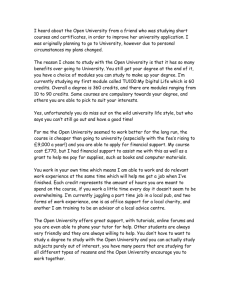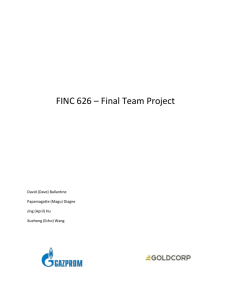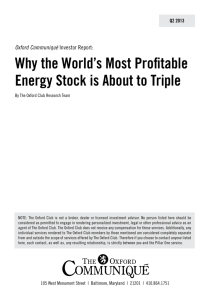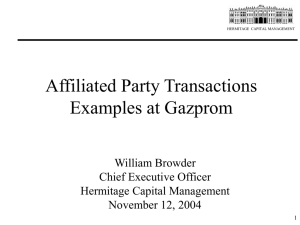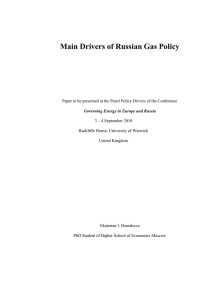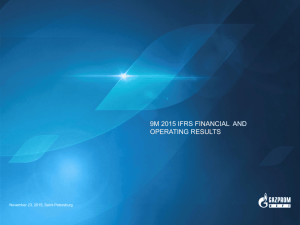The New York Times, April 25, 2007
advertisement
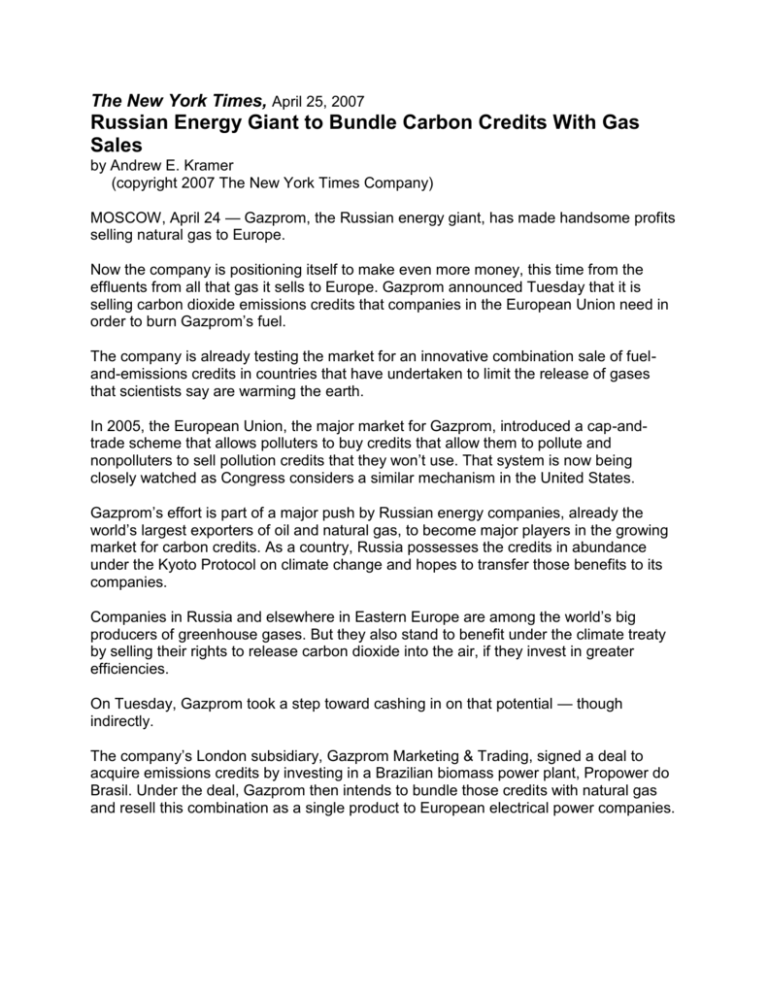
The New York Times, April 25, 2007 Russian Energy Giant to Bundle Carbon Credits With Gas Sales by Andrew E. Kramer (copyright 2007 The New York Times Company) MOSCOW, April 24 — Gazprom, the Russian energy giant, has made handsome profits selling natural gas to Europe. Now the company is positioning itself to make even more money, this time from the effluents from all that gas it sells to Europe. Gazprom announced Tuesday that it is selling carbon dioxide emissions credits that companies in the European Union need in order to burn Gazprom’s fuel. The company is already testing the market for an innovative combination sale of fueland-emissions credits in countries that have undertaken to limit the release of gases that scientists say are warming the earth. In 2005, the European Union, the major market for Gazprom, introduced a cap-andtrade scheme that allows polluters to buy credits that allow them to pollute and nonpolluters to sell pollution credits that they won’t use. That system is now being closely watched as Congress considers a similar mechanism in the United States. Gazprom’s effort is part of a major push by Russian energy companies, already the world’s largest exporters of oil and natural gas, to become major players in the growing market for carbon credits. As a country, Russia possesses the credits in abundance under the Kyoto Protocol on climate change and hopes to transfer those benefits to its companies. Companies in Russia and elsewhere in Eastern Europe are among the world’s big producers of greenhouse gases. But they also stand to benefit under the climate treaty by selling their rights to release carbon dioxide into the air, if they invest in greater efficiencies. On Tuesday, Gazprom took a step toward cashing in on that potential — though indirectly. The company’s London subsidiary, Gazprom Marketing & Trading, signed a deal to acquire emissions credits by investing in a Brazilian biomass power plant, Propower do Brasil. Under the deal, Gazprom then intends to bundle those credits with natural gas and resell this combination as a single product to European electrical power companies. Propower has carbon credits to sell because it uses renewable fuels, which emit approximately the same amount of carbon when burned as had been absorbed in the previous growing season, making its power “carbon neutral.” Nonrenewable fuels, like gas, oil and coal, in contrast, release carbon that has been sequestered for millions of years. In a statement, Gazprom described the transaction as gaining experience in the market to eventually sell carbon credits originating in Russia, together with its gas. The Kyoto treaty, negotiated in 1997 and adopted by 36 industrial nations, established a mechanism for finding the cheapest way to curb emissions of heat-trapping gases. Under the treaty, countries that produce more than their limit will reach their goals by buying rights from producers in other countries where controlling output is cheaper or easier to accomplish. In Russia, for example, industrial plants are such antiquated polluters that even modest technological improvements would yield great reduction in carbon emissions. Gazprom says it can use this process to add value to natural gas sales, because European utilities have shown interest in buying fuel together with offsetting emissions credits. “This shouldn’t be seen as a one-off deal,” Klaus Reinisch, director of new business development at Gazprom Marketing & Trading, said in a telephone interview from São Paulo, Brazil, where he was closing the deal. “If you want to be global trading operation, you need a global portfolio.” Gazprom is competing with commodity traders, hedge funds and some large American banks. But as with its energy business, it has an overwhelming advantage as a state company in gaining access to the Russian supply. “Russia is the Saudi Arabia of carbon,” said Philip A. Dewhurst, a spokesman for Gazprom Marketing & Trading, referring to carbon emissions credits. “There is a tremendous bank there. Gazprom is in this business for the long term.” Gazprom is new to his market, making its first simple carbon trading deal in November. It sold natural gas — bundled with carbon emissions credits it bought on the European exchange to burn it — to Deeside Power, a British subsidiary of International Power. Under its evolving model, Gazprom aims to offer “carbon neutral” energy to utilities in Europe, using both Russian gas and Russian emissions credits. Back in Russia, meanwhile, Gazprom is quickly moving into the business of securing emissions credits to resell in Europe. While it holds potential to reduce emissions by fixing leaks in pipelines at its own fields, Gazprom also wants to invest in efficiencies at other Russian companies. To help do that, Gazprombank, the gas company’s banking subsidiary, set up a carbon trading unit with Dresdner Bank, called Carbon Trade & Finance. That joint unit will generate carbon emissions credits by investing in modern and efficient equipment at Russian industrial polluters, thus creating credits that can be resold in Europe. One obvious source is Unified Energy Systems, the Russian electricity company and operator of huge, outdated coal-fired power plants. The company has identified itself as the world’s largest corporate emitter of the heat-trapping gases believed to be a major cause of global warming. As such, it holds great potential to reduce emissions through relatively cheap upgrades to more modern equipment. Unified Energy’s carbon trading division, called the Energy Carbon Fund, has a waiting line of interested buyers. In the past year, company officials say they have been approached by foreign commodity traders, hedge funds, car makers and large banks including American financial heavyweights, like Morgan Stanley and Merrill Lynch. For now, Russian private companies are ahead of government rules, but they only do deals outside of Russia. Deals cannot be closed at home because the Russian government has not passed legislation to implement the Kyoto Protocol domestically. Government officials promised the legislation last year; now they say it will be in place this summer. In 2004, when Russia ratified the Kyoto Protocol, officials here estimated Russian companies could attract $6 billion to $9 billion in investments into emissions-reducing technologies. In futures trading for contracts maturing next year in Europe, prices are about 15 euros per carbon credit. One carbon credit offsets one ton of carbon emissions. In total, Russia can reduce emissions under the Kyoto Protocol by two billion to three billion tons of carbon dioxide by 2012, according to government figures. At current prices, the total value for Russian carbon credits could be between 30 billion and 45 billion euros, or about $40 billion to $60 billion. But if negotiations to extend the Kyoto Protocols collapse, carbon credits could be worth nothing.




